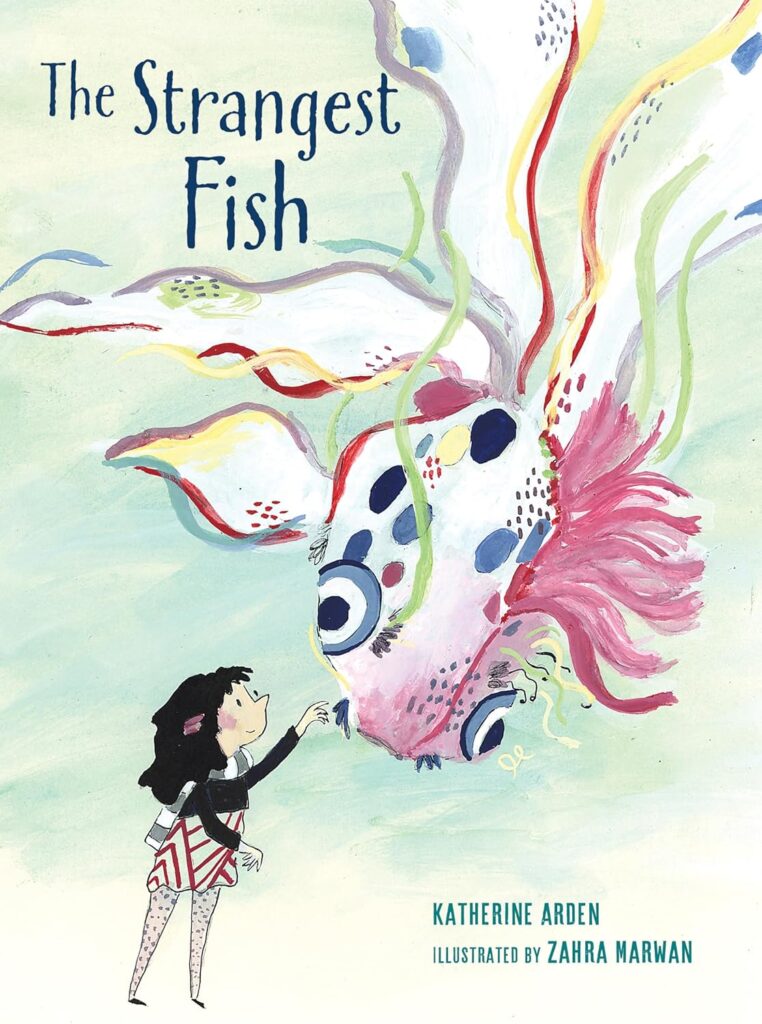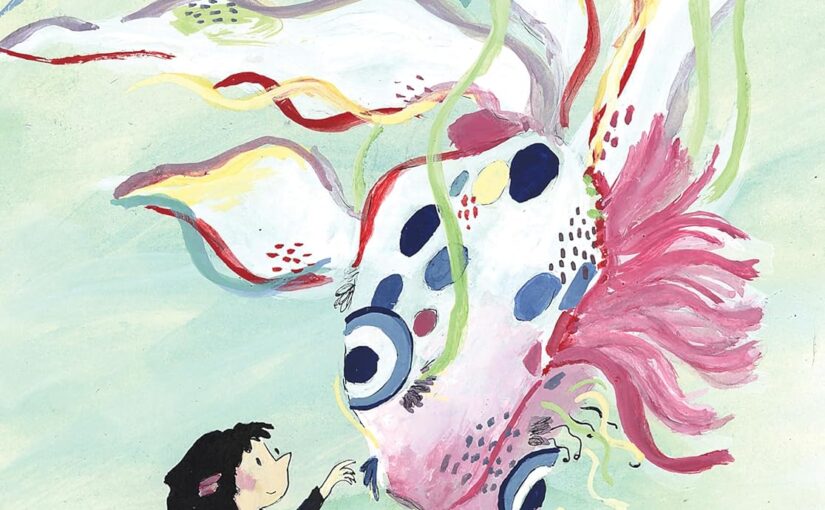What a simple tale The Strangest Fish is. It will sound familiar to young, read-aloud audiences in elementary school, both in its setting and in its very subtle lesson. A young girl is at the fair with her family when she receives a fish who is happily unaware of the size of its plastic bag aquarium. It’s a beautiful fish that they name October, who quickly outgrows his arrangements. This all sounds familiar, the fish-out-of-water, except those who aren’t like you premise that savvy readers can detect from far away. That’s us too, but before you put this in the same tank with other, less intelligent, classy or interesting books, check out the art.

The cover’s art from illustrator Zahra Marwan demonstrates a glimpse into the imagination flakes that are sprinkled on our liquid surface. There’s a cute young girl, Daisy, touching the nare of an impossibly large and colorful Siamese fighting fish. The fish is bigger than Daisy, with wispy fins that trail five times longer than its stout oval shape. Curious reads will be drawn into The Strangest Fish from that artwork and the book’s title.
When young readers turn the cover they’ll see the art really start to pop. Daisy is illustrated with a hard ink outline, with dreamy colors that don’t run too much that make up her clothing and foreground. The background around her is a soft, blotchy landscape that’s lush with anticipation and a chaotic sense of endless wonder. It’s obvious that the book takes place in the fall, because of the many colors in the forest, but it’s a hazy, blurry scene that’s dominated by Daisy and her laser-like appearance. If The Strangest Fish were a music genre it would be shoegaze.
That music has a strong, ongoing beat, but also has droning, dreamy qualities that can jump from somber storytelling to crystalline energy at a moment’s notice. Daisy is going to the fair with her family. It’s a beautiful fall day with minimal crowds and her family having a great time. Her siblings win cool prizes from the games, like a whistle and a stuffed koala, but she wins a real fish. It’s not even a normal fish, it’s strange and has far too many fins. When they get home they decide to call it October and transfer him from the bag to a more spacious bowl.
However, when they wake up, October has outgrown his bowl and is unable to swim around. Daisy puts him in an even bigger bowl, but after one night the same thing happens and he’s face-first against the glass. The family decides to do something radical and puts October in the bathtub, but the next morning Daisy is greeted by a fish that’s about to burst out of the bathtub.
She looks at October and the two share an unspoken command and action that he be set free in the local pond. October is loaded up into Daisy’s wagon and the two take their fateful trip to the lake. That night she’s worried about him getting eaten or squished in his foreign home. The next morning she runs back to the lake and peers down into the water from the pier where she’s greeted by nothing but red, crispy leaves. After a moment a giant, multi-colored water dragon that’s big enough to ride, pops out of the lake’s surface and the two proceed to enjoy numerous trips around the water.
It’s a simple story. Some elementary audiences have heard a variation of this tale for sure. However, there are a couple of things that tilt The Strangest Fish in favor of this being better than other soft lesson stories and its ilk. This is an illustrated book and its shape is much more unique than books that this audience has seen. It’s less square and more rectangular, with the longer edge going up instead out. It’s a subtle difference and had The Strangest Fish been more landscape or square, its uniformity would’ve run contrary to the strangeness that it’s projecting. Instead, the shape leans into the oddity of the fish and helps prime the audience so that they can appreciate it more.
Young audiences might not realize all of this; it’s very subliminal and possibly not intentional. The text is very simple, but not so simple that it’s insulting to its young audiences. It tells the story in an understated manner that allows the illustrations to ask or answer details that the text doesn’t address. It’s a simple story that has many more details that imply things, but don’t state them directly. This is where the audience can talk about prizes that they got from the fair, presents their siblings got that were cooler than theirs or other things that story time people will share without a filter. When that’s done they’ll grab the book, look at the art and spend some time with a book that’ll hopefully teach them to learn to love to read.
The Strangest Fish is by Katherine Arden with illustrations by Zahra Marwan and is available on Astra Young Readers, an imprint of Astra Books for Young Readers.
There are affiliate links in this post.





 Facebook
Facebook Twitter
Twitter Flickr
Flickr GooglePlus
GooglePlus Youtube
Youtube